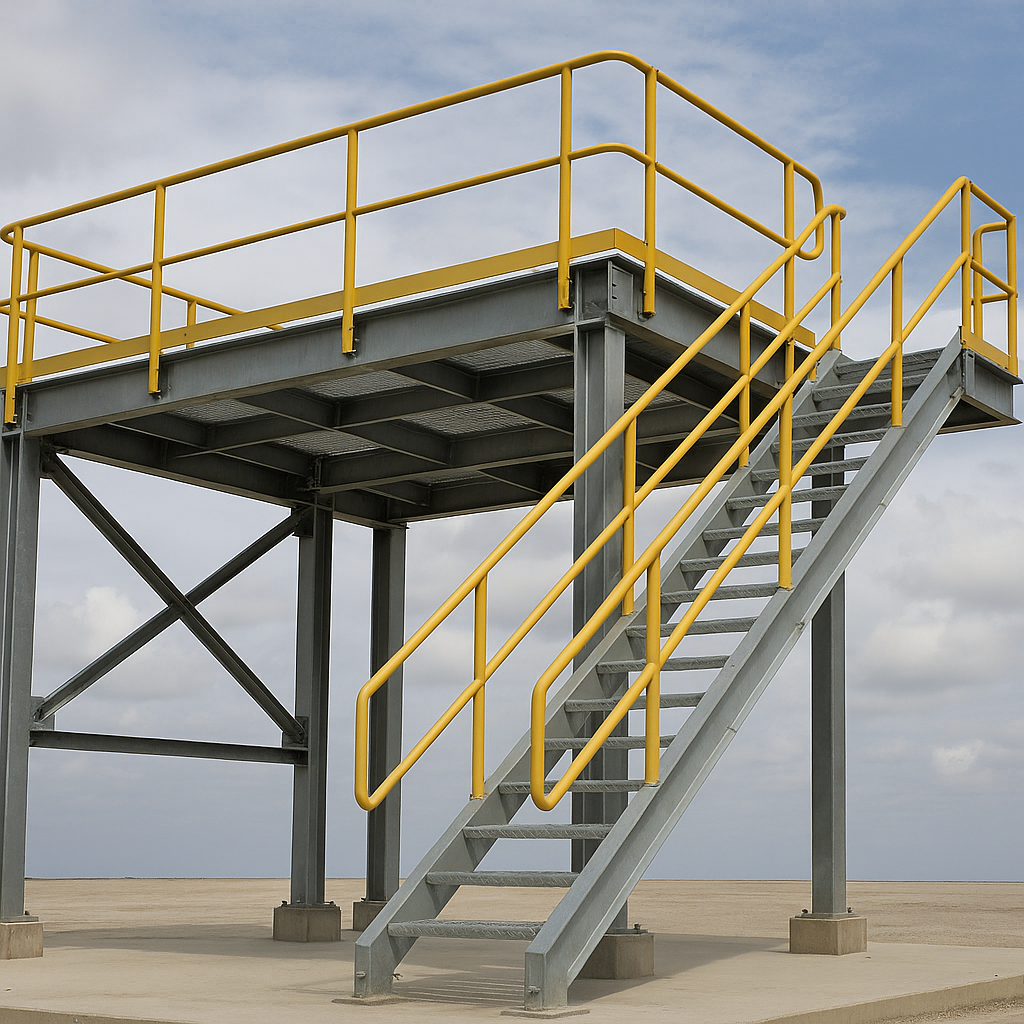Steel platforms are an essential part of modern industrial and commercial projects. They provide safe access, support heavy equipment, and create additional workspace without requiring permanent concrete structures. From oil refineries to warehouses, steel platform design plays a crucial role in efficiency, safety, and durability.
In this article, we’ll cover the main steps, considerations, and best practices for designing steel platforms according to international standards.
Why Steel Platform design?
Steel platforms are widely used in industries like oil & gas, chemical processing, power plants, and manufacturing for several reasons:
- Strength & Durability → High load-carrying capacity.
- Modular & Flexible → Easy to expand or relocate.
- Cost-Effective → Faster and cheaper than reinforced concrete structures.
- Safety → Provides secure walkways, guardrails, and access points.
- Compliance → Meets OSHA, ISO, and EN standards for industrial safety.
1. Define the Design Requirements
Every steel platform project begins with requirements definition:
- Load Type:
- Dead load: Self-weight of platform (beams, plates, guardrails).
- Live load: People, equipment, moving loads.
- Environmental loads: Wind, seismic, snow (if outdoors).
- Usage: Access platform, maintenance platform, storage, or support for machinery.
- Dimensions: Width, length, and height based on site space.
Example: In a refinery, platforms are often designed for uniform live loads of 4–5 kN/m² with extra safety factors.
2. Material Selection
The most common materials for steel platforms are:
- Carbon Steel (S235JR, S275JR, ASTM A36) → economical, widely available.
- Galvanized Steel → corrosion-resistant, suitable for outdoor platforms.
- Stainless Steel (304, 316) → used in food industry and corrosive environments.
Surface protection includes galvanization, painting, or epoxy coating to extend service life.
3. Structural Elements of a Steel Platform
A well-designed platform includes:
- Main Beams → carry the primary load (often I-beams or H-beams).
- Secondary Beams (Stringers/Ribs) → distribute loads to main beams.
- Columns (Supports) → SHS, RHS, or circular hollow sections.
- Decking/Flooring → Checkered plates, grating, or anti-slip sheets.
- Guardrails & Handrails → Ensure worker safety (typically 1100 mm height).
- Staircases & Ladders → Access to different levels.
For example, a 3 m × 4 m steel platform might use SHS 100 × 5 mm columns, NPU120 beams, and 5 mm checkered plate flooring.
4. Load Calculations and Structural Analysis
Structural integrity is the heart of platform design. Engineers must check:
- Dead Load = weight of steel members.
- Live Load = workers, tools, storage (4–10 kN/m² depending on use).
- Point Loads = equipment like pumps or compressors.
- Dynamic Loads = moving forklifts, vibration.
- Environmental Loads = wind pressure, seismic forces.
Key Calculations:
- Bending Moment (M):
(for uniformly distributed loads)
- Shear Force (V):
- Deflection:
(Must be within allowable limits, usually L/240).
Software like STAAD Pro, Tekla Structural Designer, or SAP2000 is often used, but hand calculations remain essential for validation.
5. Safety Considerations
A steel platform must follow international safety codes (OSHA, EN 1991, AISC):
- Guardrails at 1.1 m height with mid-rails.
- Toe plates (100 mm) to prevent falling tools.
- Anti-slip flooring (checkered plate or grating).
- Staircase slope between 30°–38°.
- Emergency access with at least two escape routes for large platforms.
6. Fabrication and Installation
- Fabrication → Cutting, welding, drilling, and surface finishing in the workshop.
- Assembly → Bolted or welded connections. Bolted designs allow future disassembly.
- Installation → Columns anchored to concrete foundations using baseplates and anchor bolts.
Example: A baseplate of 300 × 300 × 16 mm with four M20 anchor bolts is typical for medium-duty columns.
7. Maintenance and Inspection
Even the strongest platform requires regular inspection:
- Check for corrosion (paint peeling, rust).
- Bolt tightening for bolted joints.
- Weld inspections (ultrasonic or magnetic particle testing).
- Load monitoring if equipment changes.
Preventive maintenance extends lifespan and ensures safety compliance.
8. Advantages of Steel Platforms
- Fast Installation compared to concrete.
- Flexibility → Can be expanded or modified.
- Recyclable → Sustainable choice.
- Lightweight but Strong → Reduces foundation cost.
Conclusion
Steel platform design combines structural engineering, safety standards, and practical fabrication knowledge. By carefully analyzing loads, choosing the right materials, and ensuring compliance with international codes, engineers create platforms that are safe, durable, and cost-effective.
From refineries to warehouses, a well-designed steel platform is more than just a structure — it’s a backbone for safe and efficient industrial operations.




